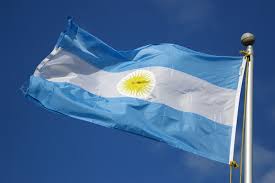
Argentina flag is composed of three horizontal stripes of equal size. The top and bottom stripes are light blue and the center is white. It was created by Manuel Belgrano on February 27, 1812, during the War of Independence of Argentina, which was then called United Provinces of Río de la Plata. Belgrano took the colors of the national cockade, which was already in use. The flag was raised for the first time on February 27, 1812 in Rosario, Santa Fe, where today is the National Flag Memorial. According to tradition, the cockade was created between 22 and 25 May, 1810. At that time the May revolution was taking place in the country; the locals wanted the independence from the Spanish. The cockade was created by Domingo French and Antonio Luis Beruti and was a symbol of liberation. It is not known why they chose the light blue and white colors, but the most accurate version is that these colors identified the Bourbon dynasty, supporters of the constitutional monarchy.
Manuel Belgrano, an intellectual and military of the time, raised the flag along with the liberation army on the banks of the river Paraná, in Rosario. The flag was made by María Catalina Echevarría de Vidal, a neighbor of Rosario.
In Buenos Aires, the flag was hoisted for the first time on August 23, 1812, in the tower of the church of San Nicolas de Bari, where now stands the Obelisk.
On March 3, 1812, the national government banned Belgrano to use the flag for reasons of international politics. They ordered him to hide it and replace it with another one. But Belgrano did not receive this order and continued using it.
After the declaration of independence on July 9, 1816, the light blue and white flag was adopted as a national symbol. On February 25, 1818 the National Congress added a sun in the middle of the flag.
No comments:
Post a Comment